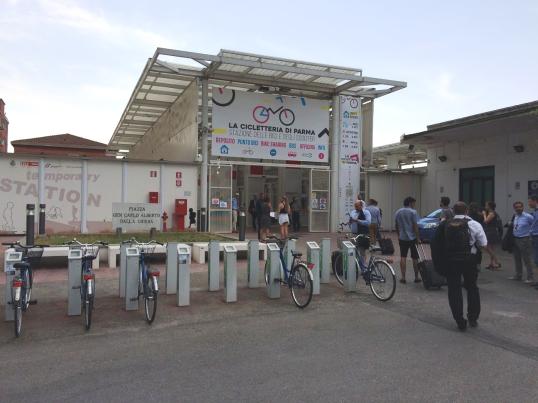- Topic
- Public and stakeholder involvement
- Urban mobility planning
- Country
- Italy
- Resource type
- Case study
first published 19/07/2017
After a two-year process that involved figures from public administration (politicians and technicians), specialists, stakeholders, committees, associations, and citizens, Parma's Sustainable Urban Mobility Plan (SUMP) was approved in March 2017 by the City Council.
Parma is the first Italian SUMP to be finalised in combination with a Strategic Environmental Assessment (SEA), thereby ensuring that environmental and other sustainability aspects are integrated into the plan. TRT Trasporti e Territorio provided technical support during the SUMP's development.
Context
Parma lies in the Po Valley, Northern Italy; one of the most critical areas in Europe in terms of air quality. It is the second largest city in the Emilia-Romagna region and has a population of 190,000 inhabitants.
According to the most recent national mobility and environmental ratings, Parma is a well-organised city with a high quality of life and good transport network, particularly with regards to bike paths and public transport.
Sustainable transport modes account for a decent amount of the city's modal share: 24% of trips are made on foot or by bike and 18% of residents use public transport. Yet around 60% of trips are still made by car and motorcycle. This is the result of a high car ownership rate, which stands at 622 per 1000 inhabitants.
In action
The SUMP development process followed EU guidelines and involved various activities linked to the SUMP planning cycle.
As part of phase 1 - "Preparing well":
- A background analysis of Parma's transport and mobility offer was conducted, which examined its strengths and weaknesses.
In relation to phase 2 - "Rational and transparent goal setting":
- Measures for inclusion in the SUMP were identified. These were selected from suggestions by policy makers, stakeholders, and citizens that were collected via online, phone and paper-based surveys;
- The SUMP guidelines were drafted. These were approved by the City Council in September 2015.
As part of phase 3 - "Elaborating the plan":
- Different SUMP scenarios were defined. These were shared successfully among policy makers, stakeholders, and public delegates;
- Technical, economic, environmental, and social evaluation of the SUMP scenarios were conducted;
- The best SUMP scenario was determined.
In relation to phase 4 - "Implementing the plan":
- The monitoring plan was defined.
The plan itself promotes:
- A regional vision that encompasses both Parma and its surroundings;
- Environmentally-friendly and low-impact transport modes;
- An integrated mobility concept in which sustainability and efficient mobility are mutually beneficial objectives;
- Safe and considerate behaviour from citizens through compliance with traffic and parking regulations;
- An optimisation of long-distance and local infrastructure and services for both passengers and goods;
- The widespread use of technology in transport systems, such as in Intelligent Transport Systems (ITS);
- The “Vision Zero” approach to road safety;
- The testing of driverless vehicles.
The SUMP includes initiatives and measures in both the central urban area and suburbs that can guide the mobility and transport sectors in the direction of greater environmental, social, and economic sustainability.
Results
Parma’s SUMP was approved in March 2017 and the first measures are currently being implemented. However, the first forecasted impacts from the ex-ante assessment of the plan are for 2025. A transport simulation model is being used to carry out a technical and environmental evaluation.
With regards to the modal share, public transport usage is predicted to rise to 24%, with walking and biking increasing to 26%. In turn, car use will decrease to 50%. The level of pollutants released during the morning rush hour is expected to fall by at least 40% (with 79% the highest prediction).
In total, around 160 million Euros will be invested in the SUMP over ten years. It will be spent on:
- The public transport network, with a substantial amount of money dedicated to renewing the fleet. This will amount to around 50% of the funding.
- Upgrades to the regional road network, including new infrastructure and safety improvements. This will account for 20% of the money spent.
- Sustainable mobility measures, including 'sharing' and e-mobility. The cycle network and related services, 'traffic calming' initiatives, and 30 km/h zones will also receive support. These measures will receive 20% of funding.
- Monitoring and parking control measures (ITS). The remaining 10% is for these measures.
Challenges, opportunities and transferability
Participatory approaches and stakeholder involvement were crucial elements of the SUMP process: citizens and stakeholders responded positively to attempts to engage them. This was particularly the case during the initial stage of the development process in June - July 2015.
The opinions of the local community were gathered through online, phone and paper-based surveys: approximately 1,300 individuals responded. Through these, the local community's priorities and needs in relation to the SUMP were identified. Moreover, since Parma's SUMP is the first Italian one to be combined with an SEA, it can serve as a reference point for other cities in the region and country.
Parma has also been selected by the Italian Ministry of Transport to participate in a working group on the harmonisation of the national transport planning law on the basis of the EU guidelines.
In Depth
- SUMP of Parma (in Italian)
- SEA of the SUMP of Parma (in Italian)
- Municipality of Parma (in Italian)
- TRT Trasporti e Territorio (in English)
- Presentation of Parma SUMP - BUMP project
- The integration of IT solutions in the SUMP of Parma - Deputy Mayor Environment and Mobility of Parma - Gabriele Folli
For further details, it is also possible to contact Ms Angela Chiari - a [dot] chiari comune [dot] parma [dot] it (a[dot]chiari[at]comune[dot]parma[dot]it)
comune [dot] parma [dot] it (a[dot]chiari[at]comune[dot]parma[dot]it)

